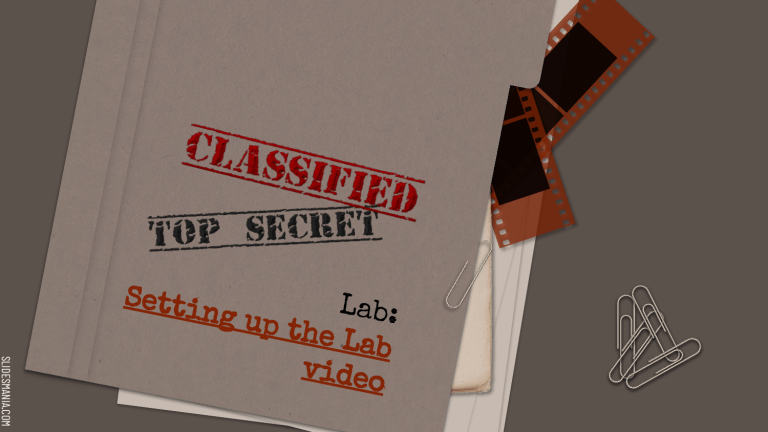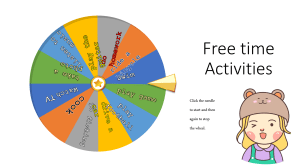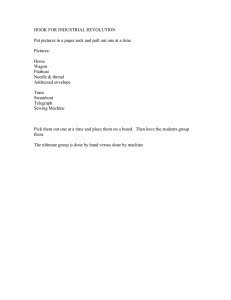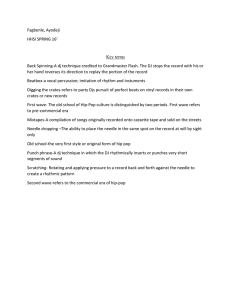
Setti ng up SLIDESMANIA.COM Lab: the L ab video Materials: 1. 2. 3. 4. 5. 6. 7. 8. 9. Teacher-prepared banana ng ts. i “victim” rk jec o b w Paper towels o n p he har Magnifying glass t, w ea s e n Scalpel e ce ar her th pa c f s o k Probe or ge ke d ot a ed dw T e n Forceps a h s: s, an or m t care o o n r Scissors p fl ar f ith io dle ee t w K sf • Scale tu ents au nee y. a c a r l e pa trum Metric ruler ep s, ap s rs pr n o y el y an ed i th p t / o t t n n fe al me poin Do i • r Sa h sc pLF pe SE t ex shar R i p OU w t u ther GY Se SLIDESMANIA.COM o • IN y. s or CT r E T ve dd RO an kni , n se ea cl k. • U s de P Procedure 1. If the name of the victim (examinee) is known, SLIDESMANIA.COM record it on the pathology report. Fill in the date and the name of the examining pathologist (you) on the report. 2. Carefully open the evidence sheet (paper towel) enclosing the victim. 3. Examine any materials in the evidence sheet or on the external surface of the clothing that may provide information about how this victim died. Use the magnifying glass to help you collect small pieces of trace evidence. Record you findings on the pathology report in the section labeled “Trace Evidence.” 4. Remove the victim’s clothing. 5. Exam the external surface of the victim. On the pathology report, note any birthmarks, scars, tattoos, or wounds. Measure these marks (in millimeters [mm]) and record the measurements on the report. Indicate the positions of these marks, scars, tattoos, or wounds on the diagram in the pathology report. 6. Weigh the victim and record the weight on the pathology report. 7. Measure and record the height of the victim. 8. Make a Y-shaped incision from the area of the shoulders to the mid chest, then down to the pubic region (see Figure 1). 9. Examine the victim internally. Record any evidence that can help you determine cause of death, such as damage to internal organs, bruising, bleeding, or wounds. 10. Examine the head externally and record your findings. 11. Using the scalpel, make an incision across the back of the head, on the lower part of the skull from ear to ear. Open the skull and look for further evidence to indicate cause of death and record any findings. SLIDESMANIA.COM EXTRA for 2022) ONLY IF WE HAVE SUTURE KITS) 12. Now that you have viewed the body externally and internally, suture the skull and the Y incision. To do so: a. Remove the curved needle with thread from the package. Gently tug on the thread to straighten it. b. Grasp the curved needle with the needle holder about two-thirds from the tip (see Figure 2). c. Gently use the toothed forceps to lift the edge of the skin farthest from you. d. Place the point of the needle against the exterior surface of the skin, about 5 to 10 mm (about 0.2 to 0.4 inches [in.]) from the incision. e. Rotate the wrist to pass the needle through the skin (from exterior surface to interior surface). f Release the needle and pick it up again on the inside of the skin. Rotate the wrist to work the needle completely through the skin. Release the skin from the toothed forceps. g. Pick up the skin nearest you with the toothed forceps. Rotate the wrist to bring the needle through the skin (from interior surface to exterior surface). h. Release the needle and pick it up again on the outside of the skin. Rotate the wrist to work the needle through the skin, leaving about a 5-centimeter (cm) (2-inch [in.]) “tail.” Release the skin. i. Tie a knot in the suture: Loop the thread around the needle holder twice. With the needle holder, pick up the “tail” of the suture thread and pull it through the loops. (This makes the first part of the knot.) Gently tug on the suture thread to tighten. Repeat the process to finish the knot. (If you have trouble tying the knot with instruments, use your hands to tie a basic square knot in the thread.) Cut the thread. j. Repeat steps a through i, using the same needle and thread until the entire incision is closed. If you need more thread, open another package. DATA COLLECTION: Take initial pictures of each direction and label the picture Include: Initial picture Surface evidence/trace evidence External surface Y-shaped incision Internal head SLIDESMANIA.COM Banana Autopsy / Pathology Report You can open link and do the work on the google doc and then put a link to your filled in document or you can do the work on the next 4 slides. (THE TEACHER MUST BE ABLE OF OPEN YOUR GOOGLE DOC TO SEE THE WORK TO GET DATA CREDIT) Deceased Information Name Sex Age (if known) Ripeness Eye Color Height Weight Hair Color Facial Hair SLIDESMANIA.COM Temperature of the body Temperature of the Air Tests and Observations Trace Evidence Collected Skin/Rigor Mortis type/describe External Examination Head External Examination (scars, wounds, markings) SLIDESMANIA.COM Internal Examination Head Internal Examination Chest and Abdominal Cavity SLIDESMANIA.COM Insert Picture of YOUR Banana with Labels Marks and Wounds Notes: Performed by SLIDESMANIA.COM (include all members of the team) Date of Exam Analysis questions (USE DATA IN ALL ANSWERS!) 1. 2. 3. 4. 5. 6. 7. WHAT TYPES OF TRACE EVIDENCE DID YOU FIND ON THE CLOTHING OF THE VICTIM? HOW COULD TRACE EVIDENCE OBTAINED DURING AN AUTOPSY BE USEFUL IN SOLVING A CRIME? WHAT KINDS OF MARKING(S) DID YOU FIND ON THE SKIN OF YOUR VICTIM? HOW COULD MARKINGS ON THE SKIN SUCH AS SCARS OR TATTOOS BE USEFUL IN SOLVING A CRIME? WHAT TYPE OF RIGOR MORTIS DID YOUR VICTIM HAVE, DESCRIBE. WHAT DID YOU FIND WHEN YOU OPENED THE BODY CAVITY OF THE VICTIM? WHAT DID YOU FIND WHEN YOU OPENED THE SKULL OF THE VICTIM? SLIDESMANIA.COM CONCLUSION: (Lab based) Use correct terminology to answer the questions. Use information in pre-lab and data. EXPLAIN FOR SOMEONE WHO HAS NO IDEA OF ANY INFORMATION ABOUT AN AUTOPSY. Based on your findings what is the time of death? How long has the body been dead… Based on your findings what was the Manner, Cause and Mechanism of death? Why is an autopsy important? Why is trace evidence important and why is an examination of the body important ? SLIDESMANIA.COM CONCLUSION: (general based) 1. What are the ways in which investigators determine time of death and what are some conditions that could increase the rate at which all different types“mortis” occurs. Answer: SLIDESMANIA.COM


